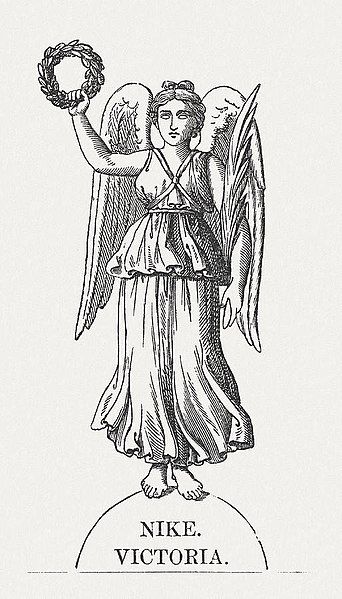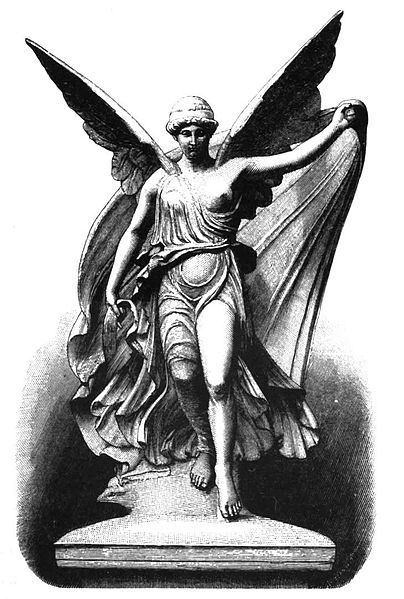In the intricate web of Greek mythology, where gods and goddesses each have their unique roles and attributes, Nike stands out as the embodiment of victory and triumph. As the daughter of Pallas and Styx, The Goddess of the Underworld River, she holds a unique position, often seen at the side of Zeus and Athena, symbolizing the ultimate success in various endeavors.
Nike Key Facts
Family tree
| Parents | Pallas and Styx |
| Partner(s) | None |
| Siblings | Kratos (Strength), Bia (Force), Zelus (Rivalry) |
| Offspring | None |
Names & Others
| Roman Name | Victoria |
| Other Names | None |
| The Goddess of | Victory |
| Symbols | Laurel wreath, Palm branch, Wings |
Name and Etymology
The name “Nike” is derived from the Greek word “νίκη,” which translates to “victory.” In Roman mythology, she is known as Victoria, a name that also encapsulates the essence of triumph. While Nike doesn’t have many epithets, her name alone is powerful enough to convey her role and significance in the pantheon.
In Roman culture, Victoria holds a similar but distinct position. While both goddesses represent victory, the way they are worshipped and their roles in their respective mythologies differ. It’s crucial to distinguish between the two, as they are individual entities with their own unique stories and attributes.
The name Nike has transcended its mythological origins to become synonymous with victory in modern language. The term is often used to describe overwhelming success or triumph, further emphasizing the enduring impact of this goddess on human culture.

Nike’s Origins
Born to the Titan Pallas and the Oceanid Styx, Nike comes from a lineage that blends both the old and new generations of divine beings. She has three siblings: Kratos, Embodiment of Divine Strength, Bia (Force), and Zelus (Rivalry), each embodying different aspects of divine attributes. Together, they were often seen as the enforcers of Zeus, the king of the gods.
There’s no specific tale detailing Nike’s birth, but her family was among the first to side with Zeus during the Titanomachy, the great war between the Titans and the Olympians. This allegiance ensured her and her siblings a place of honor beside Zeus, further elevating their roles in the divine hierarchy.
As a Daemone, or spirit, Nike personifies the concept of victory. She doesn’t just represent the outcome but the very essence of triumph, from the thrill of the win to the glory that comes with it. In this role, she is often seen accompanying other gods like Athena and Zeus, adding her divine favor to their endeavors.
Nike’s Relationships
While Nike may not have romantic entanglements that define her, her platonic relationships are deeply significant, particularly her close association with key Olympian gods like Athena and Zeus. These relationships are not mere alliances but partnerships that amplify the essence of victory in various divine endeavors.
Relationship with Athena
Nike and Athena share a unique bond, often seen together in both art and myths. As the goddess of wisdom and warfare, Athena represents the strategic and intellectual aspects of battle. When accompanied by Nike, the goddess of victory, the message is clear: wisdom and skill lead to triumph. Their partnership is a harmonious blend of intellect and the promise of success, a combination that has inspired countless works of art and literature.
Relationship with Zeus
Nike’s relationship with Zeus, the king of the gods, is especially noteworthy. She is often depicted at his side, her wings unfurled, ready to bestow the laurel wreath of victory upon him. This is not a mere symbolic gesture; Nike played a crucial role in some of the most pivotal battles in Greek mythology.
During the Titanomachy, the epic battle between the Titans and the Olympians, Nike stood by Zeus, her presence bolstering the morale of the Olympian gods and tipping the scales in their favor. Her role was not passive; she was an active participant, her essence infusing the Olympians with the confidence and vigor needed to overthrow the Titans and establish their rule.
Another significant battle was the gods’ fight against Typhon, a monstrous serpentine giant. Once again, Nike was right there beside Zeus, her very presence symbolizing the impending victory of the Olympian gods. In this battle, her role was more than just a moral booster; she was the embodiment of the triumph that comes from unity and courage, qualities that Zeus highly valued.
Depiction And Characteristics
Nike is often depicted in a manner that encapsulates her divine attributes and responsibilities.
In art and sculpture, Nike is usually shown as a winged goddess, capturing the fleeting nature of victory. She’s often seen holding a laurel wreath or a palm branch, symbols of triumph and honor. These items not only identify her but also serve as a representation of what she offers to gods and mortals alike: the sweet fruits of victory.
Her wings are perhaps her most striking feature, symbolizing the swiftness with which victory can be achieved or lost. They remind us that triumph is often a fleeting moment, one that should be cherished and honored.
Nike’s Powers and Symbol
As the goddess of victory, Nike possesses the divine ability to influence the outcome of events. While she doesn’t engage in battles or conflicts directly, her presence can inspire and turn the tides in favor of one party. This power is psychological as much as it is physical, instilling a sense of confidence and invincibility in those she favors.
Nike is often associated with the laurel wreath, a symbol of victory and honor. This association likely stems from the athletic competitions in ancient Greece, where victors were crowned with a wreath made from the leaves of the laurel tree. The palm branch is another symbol tied to her, representing triumph and eternal life.
Nike’s Roles And Responsibilities
As the personification of victory, Nike’s primary role is to bestow her favor upon those who are worthy, be it in war, athletic competitions, or any form of contest. Her presence is a seal of divine approval, a promise of triumph to those she accompanies.
Beyond the battlefield and athletic arenas, Nike also represents the victory of wisdom over ignorance, of justice over injustice. Her role is multi-faceted, extending to various aspects of life where the concept of winning and losing holds significance.
In the divine realm, she serves as an attendant to gods like Athena and Zeus, adding her essence of victory to their actions. Whether it’s Athena’s strategic planning or Zeus’s authoritative decrees, Nike’s presence ensures their ultimate success.
Myths about Nike
Nike’s myths often revolve around her role in significant battles and competitions. One of the most famous tales involves her role in the Titanomachy. As a close ally of Zeus, she and her siblings were instrumental in tipping the scales of the battle in favor of the Olympians. Her presence on the battlefield served as both a morale booster and a symbol of impending victory for Zeus and his allies.
Another notable myth is her role in the story of the Trojan War, where she is seen accompanying Athena. When Athena assisted the Greek heroes, Nike was there, symbolizing the ultimate victory that would come from following wise counsel and strategy. Her presence turned the tide in favor of the Greeks, leading to the eventual fall of Troy.

Nike In Ancient Greek Religion
Nike held a special place in the religious practices of ancient Greece, particularly in the context of athletic competitions like the Olympic Games.
The Temple of Athena Nike on the Acropolis in Athens is one of the most famous sites dedicated to Nike. This temple served as a place of worship not just for Athena but also for Nike, who was considered an aspect of the warrior goddess. The temple was adorned with friezes and sculptures depicting both goddesses, emphasizing their close association.
Another significant site is the Sanctuary of Zeus at Olympia, where a statue of Nike stood. This statue was part of the larger monument dedicated to Zeus, highlighting her role in athletic victories, which were considered gifts from the gods.
Worship and Festivals
Nike was particularly revered during athletic competitions like the Olympic Games. Athletes would offer sacrifices and prayers to her, seeking her favor for victory. While there were no specific festivals dedicated solely to Nike, her essence was celebrated during these athletic events, which were themselves considered religious festivals.
Representations Of Nike In Art
Nike has been a popular subject in art, especially during the Classical period. One of the most famous sculptures is the “Winged Victory of Samothrace,” also known as the “Nike of Samothrace,”. This is displayed at the Louvre Museum in Paris, France. This Hellenistic sculpture captures Nike in her element, with windswept wings and robes, standing on the prow of a ship. She is the very symbol of a naval victory.
Another notable artwork is the “Nike Adjusting Her Sandal,” a relief found in the Acropolis Museum in Athens. This piece captures a more serene moment. Showing Nike in a simple yet elegant pose, adjusting her sandal, a reminder that even gods have moments of simplicity.
Mentions in Ancient Texts
Nike’s presence in ancient literature is both significant and illuminating, offering various perspectives on her role and attributes. She may not be the central figure in these works. However, her mentions are impactful, highlighting her importance in the Greek mythological and religious landscape.
Homer’s “Iliad”
One of the earliest mentions of Nike comes from Homer’s “Iliad,” written around the 8th century BC. In this epic tale of the Trojan War, Nike is seen as an ally of Zeus. Following him she is reinforcing his authority and influence over the mortal realm. While she doesn’t have a speaking role, her presence is felt, especially when Zeus weighs the fates of the heroes in his golden scales. The phrase “Nike (Victory) is on my side” is often attributed to Zeus. Furthermore emphasizing that with Nike by his side, his will is destined to prevail.
Pindar’s Odes
Pindar, a lyric poet from the 5th century BC, often invoked Nike in his odes. In these works, she is celebrated as the ultimate prize, the goal that all athletes and warriors strive for. One of his famous lines, “For even wisdom is despised when a man wins not the wreath of Nike,” captures the essence of Nike as both the ultimate goal and the guiding spirit leading individuals toward victory.
Hesiod’s “Theogony”
Hesiod’s “Theogony,” another seminal work from around the 8th century BC, offers a detailed account of Nike’s origins. In this text, Nike and her siblings are described as the children of Pallas and Styx. They are described as allies of Zeus during the Titanomachy. Hesiod writes, “And Styx, the daughter of Okeanos, was joined to Pallas and bare Zelos (Emulation), and trim-ankled Nike (Victory), and Kratos (Strength) and Bia (Force).”
Through these mentions, spanning various works and centuries, Nike’s essence is captured and immortalized. These texts, while offering historical insights, also highlight the timeless nature of the values and virtues Nike represents.
Frequently Asked Questions
Nike symbolizes victory and triumph in both mortal and divine endeavors.
She is the daughter of Pallas and Styx.
Yes, she has three siblings: Kratos, Bia, and Zelus.
The laurel wreath and palm branch are commonly associated with her.
No, Nike is not known for any romantic relationships. Her focus moreover is solely on her role as the goddess of victory.
She is often shown as a winged goddess, holding a laurel wreath or palm branch, symbolizing victory.
Featured Image Credit: Edward Knapczyk, Public domain, via Wikimedia Commons
